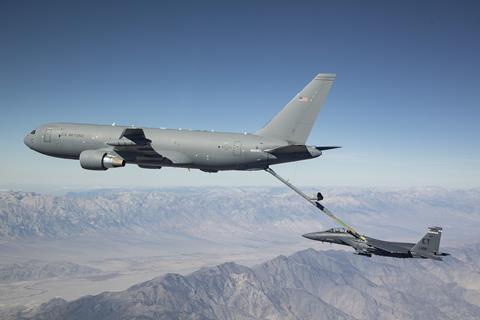The US Air Force (USAF) believes that in hindsight the Boeing KC-46A Pegasus in-flight refuelling tanker, which has been plagued with delays, functionality problems and cost overruns, might have had less problems if it was not on a fixed-price contract.
The service initially believed the tanker, which is based on the Boeing 767 airliner, would be relatively easy to develop and thus there would be low risk for delays. However, 10 years after the contract was first issued to Boeing, the USAF says new technology developed for the KC-46A likely needed additional funding support from the US government to reach a higher level of maturity.

“At the time when they decided on fixed price, they thought there was low development, and it met the criteria for why a fixed-price contract would be appropriate,” Darlene Costello, acting assistant secretary of the USAF for acquisition, technology and logistics said on 25 February at the Air Force Association’s Aerospace Warfare Symposium. “In hindsight, the fixed-price contract did cap the government cost, but it also sometimes affects behaviour because the contractor has to live within those means.”
Costello’s comments elaborate on a similar remark made by Ellen Lord, former under secretary of defense for acquisition and sustainment, in October 2020.
The KC-46A programme started with a $4.4 billion fixed-price incentive contract granted in 2011 to Boeing to design and build four test aircraft. Those test aircraft would be later modified into a final production configuration. The US government built a provision into that contract that covered 60% of cost overruns up to a $4.9 billion ceiling. Beyond that amount, Boeing had to pay for development cost overruns.
In particular, the KC-46A’s use of refuelling boom cameras, called the Remote Vision System, required a lot more development effort than initially thought. Previously, refuelling operators for older tankers, such as the Boeing KC-135 or McDonald Douglas KC-10, lay down near the tail of the aircraft and looked out a window while steering the fuel boom into the recipient aircraft. Using cameras, instead of a window, has been problematic for the KC-46A as the images produced by the system can be washed out, darkened or distorted in different situations, however.
Boeing has yet to get the Remote Vision System to work as required and that caused a delay for full operational capability of the KC-46A. In part due to issues with the Remote Vision System, but also due to other manufacturing and design problms, Boeing has lost more than $5.1 billion on the tanker programme.
The USAF seems to imply that the fixed-price contract structure is disincentivising Boeing to fix the developmental problem quickly, as all investment is at the company’s expense. Costello says fixed-price contracts should remain a tool within the service’s acquisition tool kit, but in the future might be better suited for lower-risk aircraft buying programmes.































